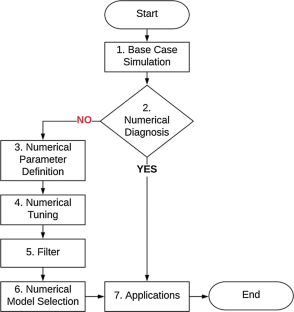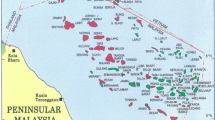Abstract
Giant carbonate oil fields in Brazilian pre-salt area present a high level of heterogeneity. Despite the fact that geoscientists aim at modelling these complex models in a high-block cell resolution, it is important to reduce the computational effort and speed up some processes such as forecasting the production during a risk analysis in a probabilistic approach. This practice must be evaluated to keep numerical and geological consistency of reservoir models. As a result, creating a procedure to assist petroleum scientists and engineers so as to reduce computational time, without losing accuracy, is the main goal of this proposed work. A methodology based on numerical parameter evaluation, tuning technique, diagnosis and application is defined to provide a robust and effective starting point of the numerical control settings during reservoir simulation model runs. All of the analyses are based on a good understanding of the reservoir heterogeneities (geologists) and characteristics (reservoir engineering) that may result in reduced central processing unit time, number of time-step cuts, solver failures and material balance compared to the default approach considered for these problems. In addition, to check the consistency of the proposed procedure, one building risk curve application for two case studies was selected, assuming that we are executing the tuning and the application in sequence of a common reservoir application. The results of the two case applications under our proposed assumptions showed that it is possible to (1) speed the simulation runs up to three times in comparison with the base case which uses the default numerical parameters of a commercial simulator, (2) reduce the number of cuts and failures and (3) control the material balance equation error within a previously defined tolerance. Despite decreasing the simulation run time in practical reservoir study applications, we are also avoiding bad combination of numerical inputs which can result in unfeasible reservoir numerical models. To conclude, depending on the amount of applications, number of runs and complexity of reservoir numerical model, the results showed that we can save time in the reservoir engineer’s routine activities while maintaining the consistency of reservoir models by dedicating an initial time to better understand and optimise the numerical parameters. Even though the vast majority of reservoir numerical models are created in high-resolution grid cells to maintain the level of heterogeneity and, consequently, increase the computational effort, more suitable numerical model quantifications should be conducted in order to reduce the running time. Nonetheless, a consistency in the reservoir model must be maintained during the entire procedure. Thus, the most important step before starting any reservoir simulation workflow is to set the numerical parameters to avoid convergence problems, to keep the consistency of the numerical simulation results (approaching the solution of nonlinear equations to the true solution) and to assist geoengineering in starting the reservoir numerical parameters consciously. In addition, we can make sure that appropriate controls of the numerical model are then being used efficiently as a practice in reservoir simulation studies, mainly before starting to run a large amount of simulations.















Similar content being viewed by others
Abbreviations
- rms:
-
Root-mean-square
- \(m\) :
-
mth grid cell
- \(\Delta t\) :
-
Time increment
- \(q_{{}}\) :
-
Production rate from the grid cell (m3/day)
- \(B_{{}}\) :
-
Formation volume factor
- \(V\) :
-
Volume of the grid cell (m3)
- \(\emptyset\) :
-
Porosity of the grid cell
- \(S_{{}}\) :
-
Saturation
- \(p_{\text{b}}\) :
-
Bubble point pressure (kPa)
- TSC:
-
Time-step cuts
- SCF:
-
Solver convergence failures
- Np:
-
Cumulative oil production (m3)
- Wp:
-
Cumulative water production (m3)
- Gp:
-
Cumulative gas production (m3)
- MBE:
-
Material balance equation
- SI:
-
Solver iterations
- NC:
-
Newtonian cycles
- TSC:
-
Number of time-step cuts
- TS:
-
Time-step
- CPU:
-
Central processing unit (s)
- NT:
-
Numerical tuning
- SD:
-
Standard deviation
- M :
-
Median
- \(n\) :
-
nth time-step
- f:
-
Fluid phase (oil, water or gas)
- o:
-
Oil
- w:
-
Water
- g:
-
Gas
References
Galas C (1997) The future of reservoir simulation. J Can Pet Technol. https://doi.org/10.2118/97-01-ge
Caumon G, Collon-Drouaillet P, Carlier L, de Veslud C et al (2009) Surface-based 3D modeling of geological structures. Math Geosci 41:927–945. https://doi.org/10.1007/s11004-009-9244-2
Mallet J-L (2002) Geomodeling. Oxford University Press, Oxford
Dubrule O (1998) Geostatistics In Petroleum Geology. AAPG Special Volumes, Tulsa, Oklahoma, USA
Dodson CR, Goodwill D, Mayer EH (1953) Application of laboratory PVT data to reservoir engineering problems. J Pet Technol 5:287–298. https://doi.org/10.2118/953287-G
Dalen V (1986) Fluid properties in reservoir simulation. Fluid Phase Equilib 29:93–108. https://doi.org/10.1016/0378-3812(86)85014-2
Whitson CH, Brulé MR (2000) Phase behavior. Richardson, TX. Henry L. Doherty Memorial Fund of AIME, Society of Petroleum Engineers
Morris CW, Ayoub JA (1989) Engineered perforation design and evaluation. In: SPE production operations symposium. Society of Petroleum Engineers
Aziz K (2000) Productivity and injectivity of horizontal wells. U.S. Dept. of Energy, Tulsa
Van Wingen N (1949) Injectivity Indices-Their Prediction and Determination. Drilling and Production Practice. American Petroleum Institute.
Stags HM, Herbeck EF (1971) Reservoir simulation models an engineering overview. J Pet Technol 23:1428–1436. https://doi.org/10.2118/3304-PA
Odeh AS (1969) Reservoir simulation…What is it. J Pet Technol 21:1383–1388. https://doi.org/10.2118/2790-PA
Johnson CR, Jones TA (1988) Putting geology into reservoir simulations: a three-dimensional modeling approach. In: Society of Petroleum Engineers (US) (ed) SPE Annual Technical Conference and Exhibition. Society of Petroleum Engineers, Houston, Texas, USA
Coats K (1982) Reservoir simulation: state of the art (includes associated papers 11927 and 12290). J Pet Technol 34:1633–1642. https://doi.org/10.2118/10020-PA
Schiozer DJ, Santos AAS, Drumond PS (2015) Integrated model based decision analysis in twelve steps applied to petroleum fields development and management. In: EUROPEC 2015. Society of Petroleum Engineers
Computer Modelling Group Ltd. (2012) CMOST user guide. Computer assisted history matching, optimization and uncertainty assessment tool, p 273
Aziz K (1993) Reservoir simulation grids: opportunities and problems. J Pet Technol 45:658–663. https://doi.org/10.2118/25233-PA
Ertekin T, Abou-Kassem JH, Jamal H, King GR (2001) Basic applied reservoir simulation. Society of Petroleum Engineers, London
Pletcher JL (2002) Improvements to reservoir material-balance methods. SPE Reserv Eval Eng 5:49–59. https://doi.org/10.2118/75354-PA
Blair PM, Weinaug CF (1969) Solution of two-phase flow problems using implicit difference equations. Soc Pet Eng J 9:417–424. https://doi.org/10.2118/2185-PA
Coats KH (2000) A note on IMPES and some IMPES-based simulation models. SPE J 5:245–251. https://doi.org/10.2118/65092-PA
Fagin RG, Stewart CH (1966) A new approach to the two-dimensional multiphase reservoir simulator. Soc Pet Eng J 6:175–182. https://doi.org/10.2118/1188-PA
Avansi GD, Schiozer DJ (2015) UNISIM-I: synthetic model for reservoir development and management applications. Int J Model Simul Pet Ind 9:21–30
Ravenne C, Galli A, Doligez B et al (2002) Quantification of facies relationships via proportion curves. Springer, Dordrecht, pp 19–39
Seifert D, Jensen JL (1999) Using sequential indicator simulation as a tool in reservoir description: issues and uncertainties. Math Geol 31:527–550. https://doi.org/10.1023/A:1007563907124
Kelkar M, Perez G, Chopra A, Society of Petroleum Engineers (U.S.) (2002) Applied geostatistics for reservoir characterization. Society of Petroleum Engineers, Richardson
Dowd P (1991) A review of recent developments in geostatistics. Comput Geosci 17:1481–1500. https://doi.org/10.1016/0098-3004(91)90009-3
Corey AT (1954) The interrelation between gas and oil relative permeabilities. Prod Mon 19:38–41
Deutsch C (1989) Calculating effective absolute permeability in sandstone/shale sequences. SPE Form Eval 4:343–348. https://doi.org/10.2118/17264-PA
Computer Modelling Group Ltd. (2015) IMEX user guide. Three-phase, black-oil reservoir simulator, p 1214
UNISIM (2013) UNISIM-I-D: case study for selection of production strategy. https://www.unisim.cepetro.unicamp.br/benchmarks/br/unisim-i/unisim-i-d
Gaspar ATF, Avansi GD, Santos AA et al (2015) UNISIM-I-D: benchmark studies for oil field development and production strategy selection. Int J Model Simul Pet Ind 9:47–55
Al-Mudhafar W, Rao D, Hosseini-Nasab SM (2016) Optimization of cyclic CO2 flooding through the gas assisted gravity drainage process under geological uncertainties
Al-mudhafar WJM (2016) Statistical reservoir characterization, simulation, and optimization of field scale-gas assisted gravity drainage (GAGD) process with uncertainty assessments. Louisiana State University, Baton Rouge
Acknowledgements
This work was conducted with the support of Energi Simulation and in association with the ongoing project registered as “BG-32—Análise de Risco para o Desenvolvimento e Gerenciamento de Campos de Petróleo e Potencial uso de Emuladores” (UNICAMP/Shell Brazil/ANP) funded by Shell Brazil, under the ANP R&D levy as “Compromisso de Investimentos com Pesquisa e Desenvolvimento”. The authors also thank UNISIM, DE-FEM-UNICAMP, CEPETRO and PETROBRAS for supporting this work and CMG, Emerson and Schlumberger for software licenses. We would like to thank Samuel Ferreira de Mello (researcher at UNISIM’s Group with expertise in PVT modelling process) for modelling the fluid.
Author information
Authors and Affiliations
Corresponding author
Additional information
Technical Editor: Celso Kazuyuki Morooka.
Rights and permissions
About this article
Cite this article
Avansi, G., Rios, V. & Schiozer, D. Numerical tuning in reservoir simulation: it is worth the effort in practical petroleum applications. J Braz. Soc. Mech. Sci. Eng. 41, 59 (2019). https://doi.org/10.1007/s40430-018-1559-9
Received:
Accepted:
Published:
DOI: https://doi.org/10.1007/s40430-018-1559-9




